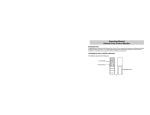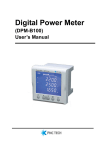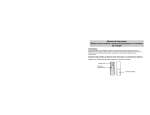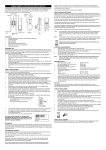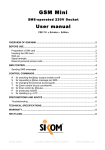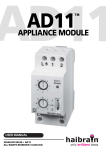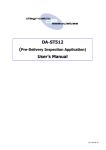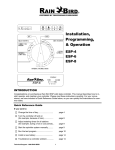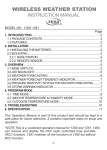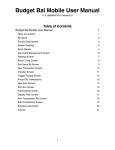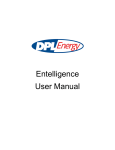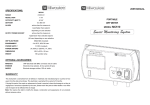Download Operating Manual Remote Cost Control Monitor
Transcript
Operating Manual Remote Cost Control Monitor INTRODUCTION: Congratulations on purchasing the Remote Cost Control. This is a state-of-the-art power monitoring socket that is highly accurate and easy to use. Please read this instruction manual before putting the Cost Control into operation as it will allow users to gain the optimum benefits of all its features. THE REMOTE COST CONTROL MONITOR: The Remote Cost Control Receiver (Figure 1) LCD Display Figure 1 Function Keys Battery Cover 24 FEATURES: Cost monitoring. Cost forecasting. Cost saving calculation. Instantaneous power consumption displays in Watt (W). Maximum load power displays in Watt (Max W). Total energy consumption displays in Watt hour (Wh) or kilo Watt hour (kWh). Total power monitor turn on time / total electrical appliance operating time displays (hour). Wireless transmission at 868 MHz. Receive up to 5 power monitors. The Power Monitor (Figure 2) Front Back Figure 2 LED Indicator/ Reset button Socket Plug 25 FEATURES: It is powered by the AC line (230V 50Hz). Each power monitor has its unique ID. Measure the power consumption of the electrical appliance, which is plugged into the power monitor and then transmits information to the receiver at 868 MHz. Transmits data every 5 seconds. COST MONITORING: Using this feature, users will see the cost of electricity running in their electrical appliances. For cost monitoring, the value is shown on the LCD as “TOTAL COST” and the information obtained will enable users to be more power consumption aware and efficient. Note: Press the Display button until TOTAL COST is shown in the lower display part. COST FORECASTING: Cost forecasting is useful for budgeting future electricity bills as the approximate cost to run an electrical appliance over a period of time can be estimated in this way. There are two cost forecasting displays screens as follows: 1) COST/MONTH = cost per month forecast (assuming normal usage) 2) COST/YEAR = cost per year forecast (assuming normal usage) Note: Press the DISPLAY button until COST/MONTH or COST/YEAR is shown in the lower display part. 26 COST SAVING CALCULATION: Once the save operation is activated the save will always be shown. When the RESET – DISPLAY – RESET key is pressed, the cost saving function is activated. The current cost/month will be stored into storage and use it as a reference value. All the displayed readings will be reset to 0. To calculate the new cost saving result, press “LRN/SCAN” to receive new data from the Power Monitor, and then press “SAVE” to show the cost saving in different displays (percent value, cost/month, cost/year). When a new cost/month is calculated then it will be compared with the reference cost/month value in the storage. There are three cost saving displays screens as follows: 1) 2) 3) In % save display, the display shows saved cost per month in percent value. If the current cost/month is bigger than the reference cost/month, a negative percent value will be displayed. In cost save per month display, the display shows the saved cost per month. If the current cost/month is bigger than the reference cost/month, a negative value will be displayed. In cost save per year display, the display shows the saved cost per year. If the current cost/month is bigger than the reference cost/month, a negative value will be displayed. The cost/year is calculated by 12 x cost/month. Note: Save operation will also be activated automatically by pressing and holding the LED button of power monitor, the LED button flashes 3 times and then lights up to indicate the Power Monitor has been reset. When the user releases the button, the LED light turns off. This operation not only will reset all the data to 0 of the receiver, but also will reset all the data in the power monitor to 0. The cleared value is used as reference value now. IMPORTANT! Before the operations of cost monitoring, forecasting and cost saving calculation, the desired power tariff must be set. (See “FUNCTION KEYS” – the “TARIFF key” section below.) 27 INTENDED USE: The measuring range of the Remote Cost Control Monitor is from approximately 0.3W to 3600W (displays 0 if lower than 0.3W) and is therefore ideal for use with a large variety of electrical appliances. Remote Cost Control Monitor is designed for use only as an indicator for the average cost and average amount of electricity used for electrical appliances. Despite its accuracy it is not officially certified and therefore readings cannot be used as evidence in any dispute between the Electricity Company and the user. Power Monitor is approved for use on a 230V / 50Hz mains supply only. Only loads with the same voltages (230V / 50Hz) can be connected. The max. load of any appliances connected must not exceed 3600 Watt (Max. current 16A). Remote Cost Control Monitor is only designed for indoor use within dry environments. Outdoor use is strictly prohibited! Remote Cost Control Monitor may not to be altered or modified in any way. Observe the specifications on the type plate of the appliance to be connected! Any other use, other than described, may risk dangers in short circuiting, fire, electrical shock, etc and damage of this product. In order to maintain perfect condition and guarantee safe operation of this product, the user must observe the Intended Use, Safety Precautions and Disclaimer Liability notes in this operating manual. SAFETY PRECAUTIONS: Remote Cost Control Monitor can only be applied to an approved 230VAC / 50Hz contact type mains outlet (VDE). 28 10% (10/16A) earth- When the Power Monitor is plugged into the 230VAC wall socket, make sure no electrical appliance is connected through the Power Monitor socket. If the Power Monitor is removed from the 230VAC wall socket, wait for 30 seconds before putting it back to the 230VAC wall socket. The max. load of 3600 Watts (16A) must not be exceeded. Otherwise, it will destroy the device. The recommended operating temperature is 0°C to +50°C. Higher temperatures may lead to dangers of overheating and permanent damage of the product. Do not operate the product within confined rooms or other adverse conditions where inflammable gases, vapors or dusts may be present! For safety, never allow the product to operate in moist conditions or to get wet. The product must under all circumstances be separated from mains supply prior any to maintenance, repair, change of parts or disassembly otherwise components and connectors carrying high and dangerous voltages may be exposed. Capacitors in the circuitry of the product may still carry high voltage charges even though it has been separated from the mains supply. Do not open the product by yourself! In commercial institutions the safety regulations of the alliance of commercial professionals associations for electrical installations and production facilities must be observed! In schools, educational institutions, hobby shops or co-operative workshops the use of the product must be responsibly supervised by trained personnel! Never insert needles, metal or any other objects into the mains outlet! Do not plug one Power Monitor into another! If the product is no longer able to operate safely, it must to be put out of operation and disposed of for reason of any accidental use when the following is evident: 29 a) b) c) d) product shows obvious signs of damage. product does not function. product has been stored in unfavorable conditions for a long period of time. heavy strain during product’s transport may have occurred. INSERTING AND REPLACING BATTERIES IN THE RECEIVER Low power batteries usually reduces the contrast of the LCD of the remote cost control receiver. If the LCD of the receiver becomes difficult to read then the batteries must be replaced immediately. The receiver uses two AAA, LR3 Batteries, 1.5V, which has an estimated average lifetime of 2 years. To replace the batteries, simply follow these steps: 1. Slide the battery cover downwards and remove. (Figure 3) 2. Remove old batteries and replace with new batteries of the same size and voltage whilst observing correct polarity. 3. Replace battery cover and secure back into place. Figure 3 Back of the receiver Battery compartment Battery cover 30 Please participate in the preservation of the environment and return all used batteries to an authorized depot. POSITIONING THE POWER MONITOR The monitor should be plugged into the AC line firmly on its back. (Figure 4) When the power monitor starts up normally, the LED indicator of the power monitor lights on for 2 seconds in the beginning. Figure 4 31 FUNCTION KEYS: THE REMOTE COST CONTROL RECEIVER The Remote Cost Control Receiver has six easy to use function keys for operation. DISPLAY key Press DISPLAY key to change the display mode: Instantaneous power in Watt (LCD displays “W”) with total cost monitoring (LCD displays “TOTAL COST”). Maximum load power in Watt (LCD displays “MAX W”) with cost per month forecasting (LCD displays “COST/MONTH”). Energy consumption in Watt hour or kilo Watt hour (LCD displays “Wh” (Figure 5) or “kWh” (Figure 6) which depends on the value, when the value is smaller than 2000Wh, it shows in Wh; when the value is at 2000 or higher, it shows in kWh.) with cost per year forecasting (LCD displays “COST/YEAR”). Energy consumption in Wh Energy consumption in kWh Figure 5 Figure 6 The total electrical appliance (e.g. television) operating time in hour (LCD displays “ON”…”h”) with total power monitor turn on time in hour (LCD displays “TOTAL”…”h”) (Figure 7). 32 Total operating time of electrical appliance in hour Figure 7 Total turn on time of power monitor in hour Press DISPLAY key long time (around 2 seconds) will display the ID of the power monitor (each power monitor has its unique ID) assigned to this channel. (Figure 8) The ID is displayed as long as the key is pressed. The channel Unique ID of power monitor Figure 8 CH/ + key Toggle between the power monitors from 1 to 5 (if more than one power monitor is used). (Figure 9) The channel: 1 Figure 9 33 SAVE key Press and hold SAVE key to display the cost save (only works when the SAVE function is activated, to activate the SAVE function, see the RESET key below). The cost save value is displayed until the key is released. Press DISPLAY key to switch the display mode. In TOTAL COST display mode: the cost save value per month in % is shown. (Figure 10) Figure 10 Cost save value per month in % In COST/ MONTH display mode: the cost save value per month is shown. (Figure 11) Figure 11 Cost save value per month In COST/ YEAR display mode: the cost save value per year is shown. (Figure 12) 34 Figure 12 Cost save value per year Note: If the SAVE function isn’t activated, the “----“ sign is displayed when pressing the SAVE key. RESET key Press RESET – CH – RESET to delete a channel. Press RESET – DISPLAY – RESET to reset the current channel data to zero. Also the SAVE function is activated. The deleted data will be used as reference value for the SAVE function. Note: When the RESET key is pressed, the “RESET” sign will be shown on the LCD. (Figure 13) The sign will off until the RESET key is pressed again or the RESET mode is time out (around 15 seconds). Figure 13 The reset mode 35 LRN/SCAN key Press LRN/SCAN key about 2 seconds to start the 6 seconds learning reception to detect new power monitor(s). The “LRN” sign and “SCAn” will be displayed during the process. (Figure 14) Press once more to confirm and store the detected channel. The learn mode Figure 14 Press LRN/SCAN key once to collect and update the instantaneous data of the already connected power monitor(s), only “SCAn” will be displayed during the process. TARIFF key The tariff should be input before the operations of cost forecasting, monitoring and cost saving calculation. Press the TARIFF key once to show the current tariff. To set up the tariff, follow the below steps: 1. Press and hold the TARIFF key for 2 seconds to enter the setting mode of tariff, the most significant digit is blinking. (Figure 15) Figure 15 Blinking 36 2. 3. 4. Press CH / + key to modify the blinking digit. Press TARIFF key to go the next digit. After setting the least significant figure, press TARIFF key again to exit the tariff mode. If exiting the setting mode by timeout, the new set tariff value will not be updated and the old tariff is still be used. IMPORTANT! If the displayed information on the receiver does not be updated or is remain unchanged for a long time, it means that the sending data from the power monitor is overflow. User needs to reset the Power Monitor (by pressing and holding its 4 seconds). The power monitor will send the overflow data when it is operated continually for around 2 years after the reset function is performed. THE POWER MONITOR The LED indicator also performed as a “reset” function for the power monitor. LED indicator Will light on for 2 seconds when the power monitor is started up (just plug into the AC line). Will flash for every transmission (around 5 seconds). When performing reset function: Press and hold the button for about 4 seconds will reset all the information to zero, except the instantaneous (W) and maximum power (MAX W). During the process, the LED button flashes 3 times and then lights up to indicate the Power Monitor has been reset. When the user releases the button, the LED light turns off. 37 SETTING UP: 1. 2. Plug the Power Monitor(s) into the AC line. About 3 seconds later, the LED indicator of the Power Monitor will light on for 2 seconds. Its means that the power monitor works normally. If not, unplug the power monitor and wait for 2 minutes. Afterwards, repeat this procedure. Performs the reset function in the power monitor again. Insert battery into the receiver, an icon “NO DEVICE” with “----“ will be shown. (Figure 16) If not, remove battery and wait for 2 minutes and then repeat this procedure. If there is already a device learned in one of the channels, you can clear the channel by pressing RESET – CH – RESET. Figure 16 3. To start the operation, it is required to connect the Remote Cost Control Receiver and the power monitor. Press LRN/SCAN key of receiver for a long time (around 2 seconds) to start the 6 seconds reception with learning of new channels. LCD shows “LRN” and “SCAn” during the learning process. (Figure 17) Figure 17 38 4. After learning reception is over the LCD shows “NO NEW DEVICE” in case no new device was found. (Figure 18) Figure 18 5. If a new device is found, the LCD shows the ID of the Power Monitor on the upper line and SCAn on the lower line. (Figure 19) Figure 19 6. 7. Press the LRN/SCAN key to confirm this Power Monitor as CH1. Or, press CH / + key to select the channel number, which should be assigned to this power monitor and then press the LRN/SCAN key for confirmation. After the right channel number is found, this Power Monitor can be learned instantly by pressing the LRN/SCAN key. If you don’t want to select the detected Power Monitor you can press the RESET key for ignoring that Power Monitor. 39 8. 9. 10. If more than one Power Monitor is detected, then a new ID of the newly detected Power Monitor will be displayed in the LCD. Repeat procedure 6 and 7 for learning another channels. Maximum 5 channels can be learnt. Long press the LRN/SCAN key again to restart at procedure 3 if not all the desired Power Monitors are learnt. After learning reception is over a scanning will be started automatically. IMPORTANT! To update and receive any data from Power Monitor, user must press the LRN/SCAN key of receiver every time to receive transmission of Power Monitor. Note: When the receiver cannot receive data from power monitor over an hour, the “NEW DATA” (Figure 20) will change to “OLD DATA” (Figure 21) displays on the LCD of the receiver. Also, the “OLD DATA” will be displayed if no valid data is detected after pressing the “LRN/SCAN” key. Figure 21 Figure 20 NEW DATA OLD DATA LOW BATTERY INDICATOR Low battery indicator is displayed on the LCD when the batteries require changing. (Figure 22) It is performed: after power up. 40 every hour the receiver automatically checks the battery status. If low battery is detected, the sign will be shown. each time when the “LRN/SCAN” key is pressed, the receiver checks the battery status. If low battery is detected, the sign will be shown. Figure 22 Low battery indicator Note: The previously stored information in the receiver will not be affected or cancelled during the battery replacing process. MAINTENANCE: Check the product for any damages at regular intervals! When cleaning the LCD and casing, use a soft damp cloth only. Do not use solvents or scouring agents. Do not submerge this unit into water. Any maintenance or repairs must only be performed by authorized service personnel being familiar with all relevant regulations. 41 SPECIFICATIONS: Absolute max. rating (short-time) - Load - Current Operating voltage Operating temperature Battery Dimensions (L x H x W) - Receiver - Power monitor (not including the plug) Resolution of LCD Range of various measurements: Instantaneous power/ Maximum power Tariff range Total Cost monitoring/ Cost per month forecasting/ Cost per year forecasting Energy consumption Power monitor operation time/ : : : : : 3600W 16A 230VAC/50Hz 0°C to +50°C 2 x AAA, LR3, 1.5V : 40.4 x 117.1 x 17.1 mm : : 61 x 83 x 83 mm 0.000 – 19.999 = 0.001 20.00 – 199.99 = 0.01 200.0 – 1999.9 = 0.1 2000 – 19999 = 1 : : 0 – 3600W 0.000 – 9.999 : : 0 – 19999 0 – 19999kWh 42 Turn on time Cost save per month/ Cost save per year Cost save per month in percent : 0 – 19999 hour : : -999 – 19999 -999 – 100% LIABILITY DISCLAIMER: The electrical and electronic wastes contain hazardous substances. Disposal of electronic waste in wild country and/or in unauthorized grounds strongly damages the environment. Please contact your local or/and regional authorities to retrieve the addresses of legal dumping grounds with selective collection. All electronic instruments must from now on be recycled. User shall take an active part in the reuse, recycling and recovery of the electrical and electronic waste. The unrestricted disposal of electronic waste may do harm on public health and the quality of environment. This product must however not be thrown in general rubbish collection points. As stated on the gift box and labelled on the product, reading the “User manual” is highly recommended for the benefit of the user. The manufacturer and supplier cannot accept any responsibility for any incorrect readings and any consequences that occur should an inaccurate reading take place. This product is only designed for use as an indicator for the average cost and average amount of electricity used for electrical appliances. Despite its accuracy it is not officially certified and therefore readings cannot be used as evidence in any dispute between the Electricity Company and the user. This product is not to be used for medical purposes or for public information. The specifications of this product may change without prior notice. 43 This product is not a toy. Keep out of the reach of children. Damage caused by neglect, misuse or failure to comply with this manual will invalidate the warranty of this product. The manufacturer cannot and will not be held liable for any consequential damages caused for the above. No part of this manual may be reproduced without written authorization of the manufacturer. 44





















